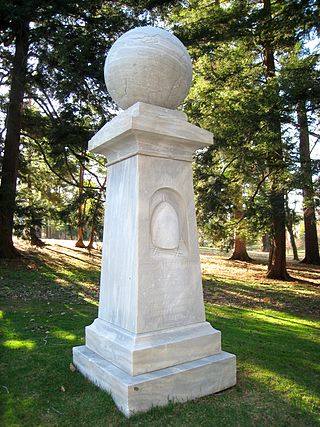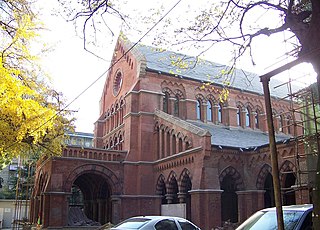
The American Board of Commissioners for Foreign Missions (ABCFM) was among the first American Christian missionary organizations. It was created in 1810 by recent graduates of Williams College. In the 19th century it was the largest and most important of American missionary organizations and consisted of participants from Protestant Reformed traditions such as Presbyterians, Congregationalists, and German Reformed churches.

Karl Friedrich August Gützlaff, anglicised as Charles Gutzlaff, was a German Lutheran missionary to the Far East, notable as one of the first Protestant missionaries in Bangkok, Thailand (1828) and in Korea (1832). He was also the first Lutheran missionary to China. He was a magistrate in Ningbo and Zhoushan and the second Chinese Secretary of the British administration in Hong Kong.

George Smith was a missionary in China and the Bishop of Victoria from 1849 to 1865, the first of this newly established diocese.

John W. Gowdy was a Scottish American bishop of the Methodist Episcopal Church and The Methodist Church, elected in 1930. He also distinguished himself as a missionary, an educator, and as a college and university president.
Medical missions in China by Catholic and Protestant physicians and surgeons of the 19th and early 20th centuries laid many foundations for modern medicine in China. Western medical missionaries established the first modern clinics and hospitals, provided the first training for nurses, and opened the first medical schools in China. Work was also done in opposition to the abuse of opium. Medical treatment and care came to many Chinese who were addicted, and eventually public and official opinion was influenced in favor of bringing an end to the destructive trade. By 1901, China was the most popular destination for medical missionaries. The 150 foreign physicians operated 128 hospitals and 245 dispensaries, treating 1.7 million patients. In 1894, male medical missionaries comprised 14 percent of all missionaries; women doctors were four percent. Modern medical education in China started in the early 20th century at hospitals run by international missionaries.

Chung Hua Sheng Kung Hui, known in English as the Holy Catholic Church in China or Anglican-Episcopal Province of China, was the Anglican Church in China from 1912 until about 1958, when it ceased operations.

The Shen-kuang-szu Incident was a series of events that took place between 1850 and 1851 in Fuzhou, China and was marked as one of the earliest conflicts between local Chinese and foreign Protestant missionaries. It began in June 1850 when two English missionaries rented rooms in a temple known as the Shen-kuang-szu on Wu-shih-shan within the walled city of Fuzhou. In the months that followed, local Chinese gentry and officials attempted in various ways to evict the missionaries from the hill, but all their efforts apparently failed. The controversy was settled the following year in October with the terms of the agreement stating that the missionaries were allowed to stay behind. This led to great discontentment amongst the local gentry and eventually foreshadowed yet another more important missionary incident—the 1878 Wu-shih-shan Case.

Rev. Robert Warren Stewart was an Irish missionary of the Church Missionary Society, London, stationed at different times in Australia, India. and Fuzhou, China, where he was martyred.

Ronald Owen Hall was an English Anglican missionary bishop in Hong Kong and China in the mid 20th century. As an emergency measure during the Second World War, with China under Japanese occupation, he ordained Florence Li Tim-Oi as the first woman priest in the Anglican Communion.

John Hind was an Anglo-Irish missionary bishop of the Anglican Church in Fukien.
The following is a timeline of the history of the city of Fuzhou, Fujian Province, China.
The Reverend Arthur Dudley Stewart (史超域牧師) (1877–1953) was a British missionary to Hong Kong and the eighth principal of St. Paul's College, Hong Kong.

The Church Missionary Society in China was a branch organisation established by the Church Missionary Society (CMS), which was founded in Britain in 1799 under the name the Society for Missions to Africa and the East; as a mission society working with the Anglican Communion, Protestant, and Orthodox Christians around the world. In 1812, the organization was renamed the Church Missionary Society. The missions were financed by the CMS with the local organisation of a mission usually being under the oversight of the Bishop of the Anglican diocese in which the CMS mission operated.
David M. Paton (1913–1992) was an Anglican missionary to China, working under the Church Missionary Society.

Chaplain to the Forces 1st Class, The Reverend Hugh Mortimer Eyton-Jones, MA (Cantab) was a clergyman, missionary and member of the Church Missionary Society, preaching the Gospel in Fuh Ning, China from 1889 – 1900, serving as Vicar of St. Paul's, Hounslow later in life.

The history of Anglicanism in Sichuan began in 1887 when Anglican missionaries working with the China Inland Mission began to arrive from the United Kingdom. These were later joined by missionaries from the Church Missionary Society and Bible Churchmen's Missionary Society. Or according to Annals of Religion in Mianyang, in 1885, a small mission church was already founded in Mianyang by Alfred Arthur Phillips and Gertrude Emma Wells of the Church Missionary Society. Missionaries built churches, founded schools, and distributed Chinese translations of Anglican religious texts. These efforts were relatively successful and Anglicanism grew to become one of the two largest denominations of Protestant Christianity in the province, alongside Methodism.
William Welton (1808–1858) was an English clergyman, physician, and surgeon. Born and raised in Wickham Market, Suffolk, England, Welton practiced as a surgeon for several years before shifting to study theology and become a medical missionary. He is credited with being the first Church Missionary Society doctor to go to China, as he went to Fuzhou, China from 1849 to 1856. He was one of two missionaries whose actions instigated the Shen-kuang-szu Incident in 1850–1851.
Birdwood Van Someren Taylor was an English physician, teacher and clergyman. He was the second Church Mission Society medical missionary to go to China in 1878, working during the height of the Opium War, with a focus on Fuzhou (Fuh-Chow), Fukien, and Hinghwa. Noted for his work addressing opium addiction and leprosy, Taylor founded mission hospitals in Fukien, including three significant hospitals with the largest in Hingwa. He incorporated medical education into the hospitals and translated English medical textbooks into the local dialects. He also served as the founding Principal of Union Medical College in Western China. Taylor was also known for bringing English lawn tennis to the Fukien area.

Rev. Wong Kiu-Taik was a prominent Chinese Christian clergyman and medical missionary in the 19th century. Born in Fuzhou, China, Wong began his career as a landscape painter before his conversion to Christianity in 1857. He became one of the first ordained Chinese ministers in the Fuh-Kien province, joining the Church Missionary Society (CMS) after his baptism by the American Episcopal Methodist Mission. Wong played a critical role in the growth of the Christian community in southeastern China, particularly in Fuh-Kien, where he was deeply involved in pastoral and medical work. His leadership contributed significantly to the development of the native Chinese church, and he is remembered for his dedication to missionary medicine, education, and spiritual service.













